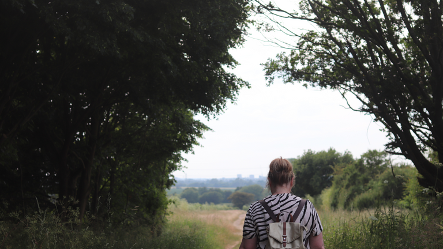
Sometimes, we receive gifts of wisdom that stay with us, shaping the way we move through the world. One such lesson has lingered with me: everything is rhythm. It’s a principle I first encountered years ago, but it guided me through many moments of life, including on the radical pilgrimage along the Saffron Trail – a 70-mile journey across Essex.
The rhythm of life isn’t just confined to music – it’s in the way we walk, the way the seasons change, and the way places breathe. As an artist, co-producing this programme of happenings and coordinated public walks with Essex Book Festival meant that the radical pilgrimage along the Saffron Trail could become a natural extension of this rhythm. It was an opportunity to bring it into collective practice, all culminating on June 21st at Saffron Hall in Saffron Walden. There the hypnotic rhythms of Mohammed Erebbaa, the Gnawa music, henna, and the scent of saffron rice perfumed the air.
The Saffron Trail weaves across Essex from south to north, beginning at Southend Pier and hugging the Thames before moving inland through woodlands, fields, and ancient paths. The trail eventually reaches Saffron Walden, a town deeply rooted in the history of saffron cultivation, giving the trail its name. Each step along the trail felt like part of a larger rhythm, a dance between the past and present, the land and the people who inhabit it. This rhythmic movement felt even more pronounced as the solstice approached, the energy of the earth palpable in the landscape.
Walking out toward the low tide—
Mother of Mercy meets a version of me:
Submerged, cooler, I missed the train on both ends of the pier,
A reminder to blow away the cobwebs—
Seaside, seaweed, pebbles underfoot.
Chalkwell House, roses bouncing,
Blossoms flourishing furiously.
No smell though, not like Pakistan’s humble roses—
To the eye, enchanting.
We walk the old cinder path,
No soot or smoke from the old coal.
Just teenagers, topless, and Jewish mothers with their babies,
Watching children paddle.
Half-burnt bodies lie flat-faced in the sand,
Warships of fiberglass bring shade
To those behind the mesh fence.
Horseradish, elder, hawthorn, purslane—
All look on.
We walk up the hill, past the station,
Where Elm stands bright in its ancient glory.
Corridors of roses and oak, hazel and horsetail too.
Butterflies, fields of chamomile—
A leaning tower, a castle, tea rooms.
The town centre of Benfleet in the great woods,
Underneath the coppiced beechwood.
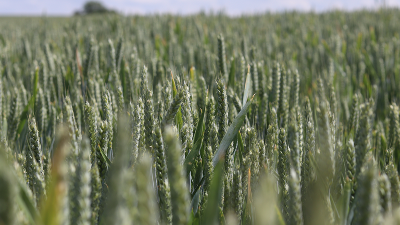
The trail highlights the wealthy lung of Essex, as it takes you through the backyards of the large Essex mansions to the high-rise commuter belt flats. The culture of Essex is retold through vinegared cockles by the estuary mudflats, oat milk flat whites by woodland oaks, and Turkish mezza to the seemingly endless stretches of arid monocrop wheat fields. These interactions, juxtaposed against the varying landscapes, reminded me of the complex history of power and land, especially as we passed through Great Waltham, where the Saffron Trail intersects with the Essex Way. Here, the old estate of the High Sheriff of Essex stands as a reminder of 18th-century landownership, its formal gardens and picturesque parkland a living relic of money and power over nature. In Blakes Wood, Essex’s second-largest area of common land, managed by the National Trust, we walked amongst mighty turkey oaks, chestnuts, and coppiced hornbeam. Tall foxgloves stood proudly amongst the canopy. Further in, we crossed little streams and noticed the fences that kept us confined to single-file footpaths, with a few signs that offered a more unwelcoming tone – reminders that not everyone experiences the countryside as an open, accessible space.
But beneath the surface of this control lies a deeper history, one of commoners grazing animals and gathering wood on common land, a time when people and land were intertwined in ways we’ve largely forgotten. In this way, the pilgrimage was also about reclaiming that connection, remembering what it means to walk freely on the land. I felt it each time my feet connected with the flint-lined paths that had been trodden for centuries.
The Saffron Trail is named after the precious that once grew prolifically in Essex. Saffron, a plant with origins in South West Asia and North Africa, was smuggled into England centuries ago by a pilgrim, as legend tells it. By the 1500s, the town of Chepyn Walden had become Saffron Walden, a place where saffron thrived and transformed the local economy. In ancient mythology, saffron is linked to Persephone, who, when abducted to the underworld, triggered the cycle of seasons. The blooming of the saffron crocus in autumn is said to signal Persephone’s return to the underworld and the start of the darker half of the year. In this way, saffron symbolises death and rebirth, echoing the cyclical rhythm of life that we encounter on every pilgrimage. This myth parallels the resilience of the saffron plant itself, which has adapted to new landscapes just as the Gnawa people of Morocco did, bringing their powerful music with them. As I walked the Saffron Trail, I reflected on these stories of adaptation, migration, and transformation. Saffron may not be native to Essex, but its presence has shaped the land’s history.
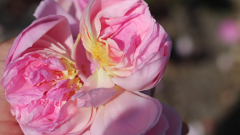
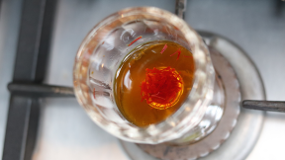
Saffron’s history in Essex is rich with stories of adaptation and transformation, much like the plant itself. Once, saffron was not only prized and sold internationally but also used to dye Irish linen, its bright orange stigmas from the Crocus Sativa plant yielding threads that were harvested exclusively by hand. Prior to setting off I ran a workshop with a school in Saffron Walden where we experimented with dying the fabric. Its potent pigment and distinctive fragrance have long been revered. In the Buddhist monastic tradition, saffron’s alchemical reaction with fabric created the warm orange robes worn in service of the divine, symbolising purity and devotion. This ritualistic process mirrors the pilgrimage itself – with each step and breath, we are reminded of our relationship with the plants and the land. Yet, in the depths of modernity, we’ve forgotten that we are a part of nature. Walking along the Thames Estuary, where the Industrial Revolution’s legacy still lingers, the contrast between the perversion of our relationship with nature and the resilience of plants like saffron becomes painfully clear.
I am ever so grateful that this work was free for all to participate in and not yet another “paid-for” nature connection activity. Nature is commodified enough as it is, and we need to reclaim our right to connect with it freely. We’ve forgotten what it means to be good stewards of the land, even though we remain in a coexistent, symbiotic relationship with the plant world. We need them.
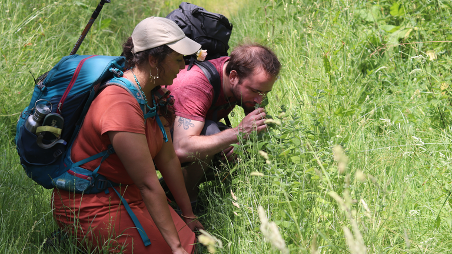
Saffron teaches us the importance of adaptation. Like how saffron learned how to thrive in new conditions, we too must evolve and adapt in these times. Saffron is said to have nearly 100 medicinal gifts; its chemistry is extraordinary, containing over 150 volatile and aroma-yielding compounds. In a time when we are witnessing changes in natural rhythms and cycles, saffron holds deep wisdom if we are willing to listen.
I am a daughter of migrants here, I felt the warmth of saffron itself welcoming me, offering lessons through subtle exchanges between the land and its people. As we tread these paths, the connection to the earth beneath us sparks inner transformation. Yet there were moments on this journey that reminded us of the exclusion many still feel – signs that made clear the limits of welcome and access. These moments serve as reminders that access to the land and the feeling of belonging are not always extended to everyone. The Saffron Trail, with its name rooted in the rich history of saffron – a spice, and celebrated migrant integrated into Essex soil– offers a powerful symbol of how diversity can enrich our connection to nature. Just as saffron’s vibrant energy blends with the earth, so too must our landscapes embrace the diversity of people who walk them. Footpaths can provide a practical starting point for opening up the landscape, but they must also platform the need for inclusion, opening the countryside for all to learn, heal, and connect through the energy of the land.
During the Hockley leg of the walk, I learned about the antiviral medicines of pine from Marley, who walked with me, and I was reminded of the sense of belonging we cultivate when we immerse ourselves in nature. As I have been looking through archival footage these past few weeks and listening back to voice notes on my phone, I came across a recording of a poem that captured an encounter I had upon this stretch of the walk, somewhere between Southend and Chelmsford:
Road Walking in Essex
I was tickled by nettle in the back lanes of borage
Reminded of
Exclusion on arrival, n***** and p**** go back home
Danger of death if you walk amongst the hemlock line
Humbled by giants
Not some folk unkind
Words etched in deadwood
Now the hemlock stands 7 or 8 ft tall,
Higher than the shoulder
Amongst chestnuts and oaks
That could just at any moment fall weak
But still growing new shoots from the side
Pine scatters needles
Many days we will walk amongst that which isn’t understood
Maybe, but I rustle past quickly.
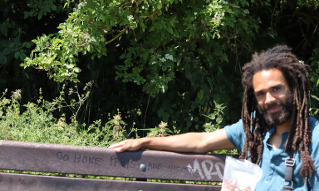
The landscape was alive with both beauty and challenge. Every step along the trail, whether through the woods of Danbury or along the former railway line of the Flitch Way, was an invitation to dissolve the illusion of separateness and reconnect with the land and it’s rhythm. Working with book festival enabled me to focus of my exploration of ecoliteracy, how do we read the landscape? How can we hear, see and feel it’s rhythm? As we journey through life, it is our task to deepen our relationship with the living world, around us and within us.
The solstice energy heightened this connection. Immersion in nature brings us closer to a primal part of ourselves, cultivating a sense of belonging. The timing of the pilgrimage was significant – the journey led me to this conclusion on the summer solstice, the longest day of the year, a time of heightened energy, illumination, and connection. Known in herbal astrology as a fire herb, saffron’s vibrant energy perfectly mirrors the power of the summer solstice, a time of peak light and transformation, when the fire of the sun marks a turning point, a moment when light lingers at its peak, symbolising both culmination and the start of a new cycle.
Urbanisation often distances us from the natural world, and this pilgrimage offered a way to bridge that gap and collaborating with organisations working together to transcend these boundaries culturally, enabling the journey to happen. We collectively tested what it means to build a working partnership with the land and each other through the Saffron Trail. As a part of the Essex Book Festival, our goal was simple: to reconnect people and organisations with the county’s diverse ecology, heritage, and cultures. I want to extend my gratitude to Metal, Essex Writer’s House, Essex Cultural Diversity Project, Chelmsford City Council, Chelmsford Cultural Development Trust, Taliston House and Garden’s and Saffron Hall and St Mary CVE school for collaborating, supporting and contributing to this partnership.
I stayed a night at Talliston House and Gardens where I encountered a labyrinth stone in the front garden. Taliston was just one part of the greater unfolding on the Saffron Trail. Every step mirrored this labyrinthine quality. The journey was a constant call to embrace the unknown and trust in the unfolding. The labyrinth became metaphor for the pilgrimage itself – not a straight line, but a winding, circular path, one that invites reflection with each step just as the pilgrimage does not follow a predictable route. There are twists and turns, unexpected moments, and a need to trust that the path, however winding, will lead you to where you need to be. I remember leaving Chelmsford, it cracked me, it was a part of the walk where I had no one walking with me, my feet were tired, my body was aching. I remember standing underneath a fruiting rowan tree in a carpark in the rain, asking myself why on earth am I doing this, no rain coat, all whilst on a personal level my to-be then husband was moving us out of the house we were living in, yet still showing up on time to watch me make a ceremonial saffron coffee. I mustered up the energy after sleeping in the Room of Dreams, to retell the old story of how coffee and people met, and the mysteriousness of the real origin of Saffron. I blended an elixir combing an Egyptian coffee blend, I bought back with me from my last trip to Egypt, warm spices of ginger, cardamom, rose, nutmeg and Saffron, filling the kitchen at Taliston house all accompanied by one of festival director Ros Green’s famously delicious Saffron Cakes.
From coffee shops to convenience shops, I’d tell people, “I’ve walked here from Southend.” “Wow, that’s far!” they’d say. That sense of distance was profound, yet the plants kept me grounded in something familiar. Tall overgrown paths stung us with nettles, brambles scratched at our arms, and wild cherries, mint, lemon balm, and pineapple weed sustained us along the way.
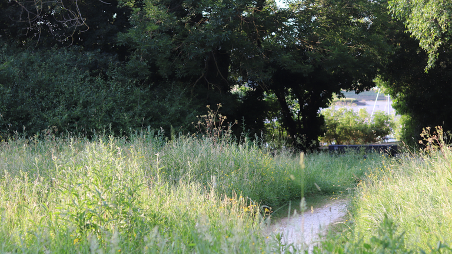
Green brambles
Closed buds in the mind’s eye
Rosebush scratches on my neck
Nettle embodiment lingers
Harshness of pollen
Sweetness of nectar Petal guidelines to the sou
Brushing past overgrown tourist season
Into the dark thunder moon
Transformed winds of change
My journey reached its peak at Saffron Hall on June 21st, where the deep, trance-like rhythms of Gnawa music filled the space. Mohamed Errebbaa and his band from Gnawa Bristol performed a concert introducing the hypnotic pulse of the gimbri. This concert was the culmination of not just my physical walk, but the internal pilgrimage that had unfolded along the way. The timing of the concert aligned with the summer solstice, a time when the earth itself feels alive with energy, when the days are longest and light fills the landscape.
The solstice energy echoed through the Gnawa rhythms, blending with the rhythm of my journey across the land. Gnawa music, with its origins in the sub-Saharan people brought to Morocco, carries a rhythm that transcends place and time, much like the land I had walked through. It reminded me of the slow, deliberate steps I had taken through the woods and fields, the ancient rhythms of the land speaking through the music. The concert wasn’t an ending, but a deep reminder that everything is connected – music, land, people, rhythm.
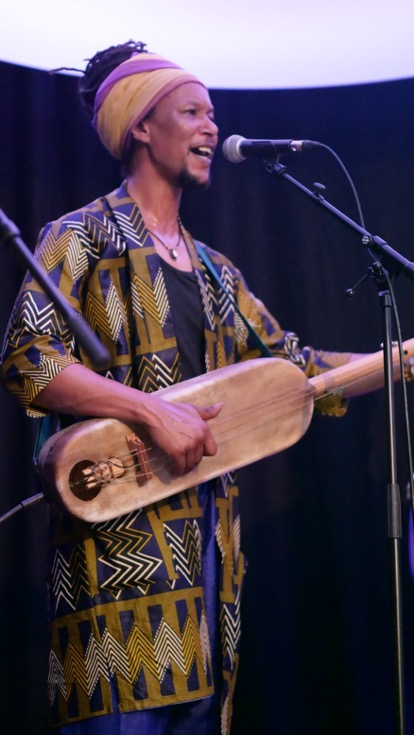
On these sacred journeys, we are called to remember what it means to walk gently on the earth and how we can honour the wisdom it holds. We can observe the layers of history that we cannot denounce – the flint tells all. Life offers us many moments of disorientation, much like this pilgrimage, in the lands where I have rooted, grown, and created. There are many times in our lives when we are pulled away from the familiar and into the unknown. It has taken me over a year to produce this finished blog, well, because life has no direct line. But it has been in these moments of grand unfamiliarity, where certainty dissolves into the natural rhythm of it all. And what better time to publish this blog than during the saffron harvest season, a perfect way to honour the crocus as it blooms and celebrates its own cycle of renewal.
Saffron has been a teacher, slowly burning its fire in me over the past year now. My journey with it is a continued pilgrimage, a sacred act, the begetting of plant medicine and teaching its importance in a county where its story was once told. The path is filled with lessons – the subtle exchanges between a place and its people, the ground we tread, and the inner transformation that occurs as we move through these spaces. My son Zeki was given the due date of June 21st, a whole year after the culmination of the pilgrimage. Some do say it is a fiery plant of fertility.
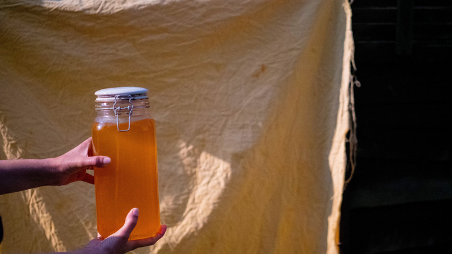
Since the pilgrimage, I’ve been exploring creative collaborations that align the Saffron Trail with climate justice. My recent work involves potential residencies and exchanges in the saffron-growing region of Talouine in the Atlas Mountains. Although saffron remains a profitable crop, it is highly water-dependent. Local farmers are already experiencing climate impacts: irregular rainfall, rising temperatures, shorter cold seasons, and less snow. These changes are disrupting the saffron crop’s productivity, affecting the broader ecosystem and reducing agricultural yields, livestock, and water resources. As a result, many young people are leaving for city jobs, with fewer hands left to maintain the saffron production.
Despite these challenges, some farmers are adopting adaptive practices, working to sustain their cultural heritage and the saffron trade amidst the climate crisis. Their efforts reflect the same resilience and cultural significance that saffron holds, both in Essex and globally.
A pilgrimage, in many ways, is a radical act – an act of trust, of letting go, and of being open to whatever unfolds along the way. My pilgrimage on the Saffron Trail was made possible by the people who walked with me, hosted me, and nourished me along the route. To all those fellow pilgrims, I offer my deepest gratitude. This journey was not just mine, but ours.
As pilgrims of life, we are called to deepen our relationship with the living world around us. Walking the Saffron Trail was a sacred act, one filled with the lessons of the land, of history, of plants, and of music. Life itself is a pilgrimage, and the path is never linear. The rhythm of our footsteps, the landscapes we move through, and the inner transformation that occurs as we journey are all part of the greater rhythm of existence.
So I ask you, how can we cultivate a sense of sacredness in the everyday? How can we honour the rhythm of our own footsteps in co-creation with the ground we tread upon?
May we walk in gratitude, as pilgrims of the human experience.


Lora Aziz
Herbcrafter, nature storyteller and creative producer
lora@wyrdflora.com
@wyrd_flora
wyrdflora.com


